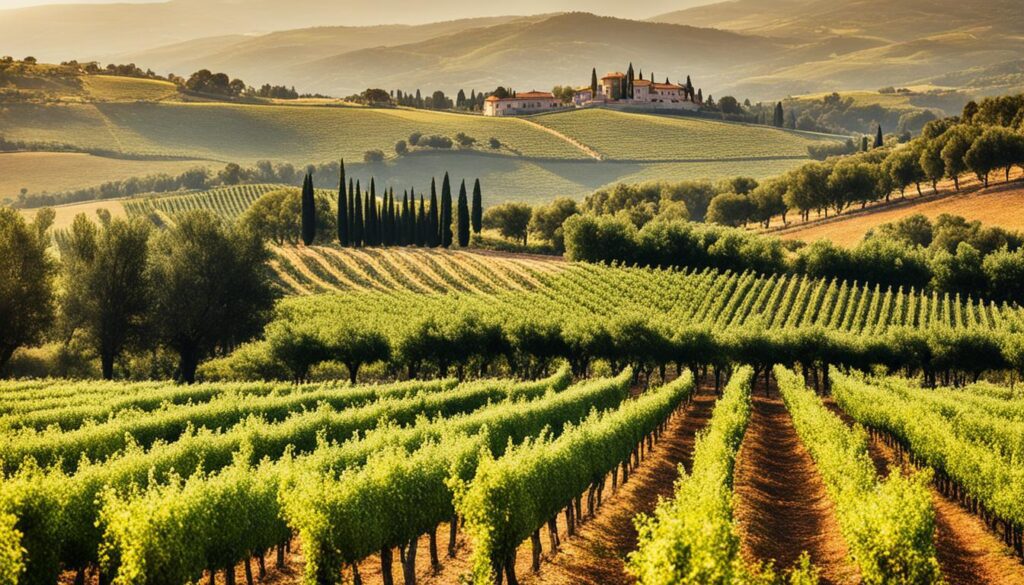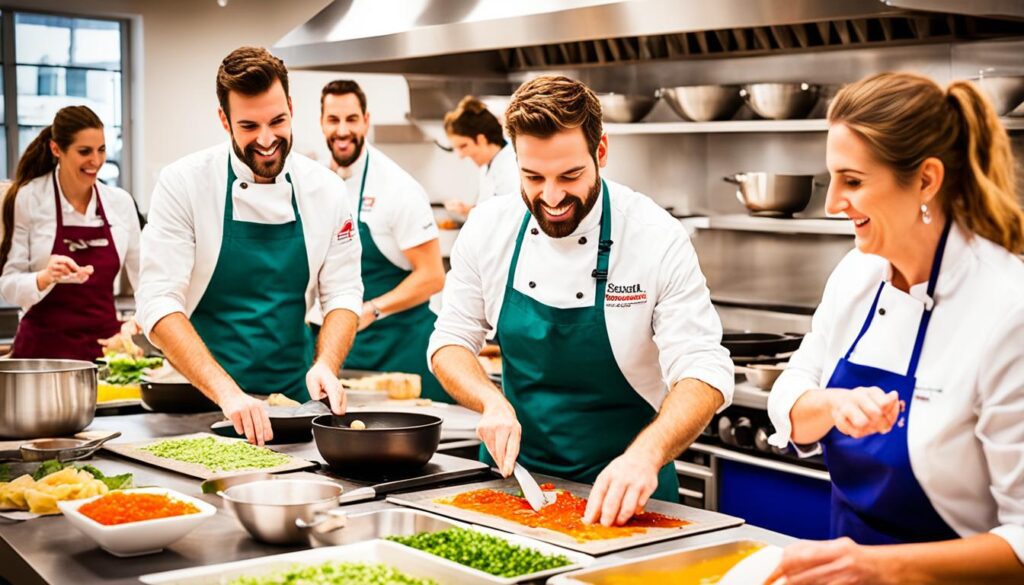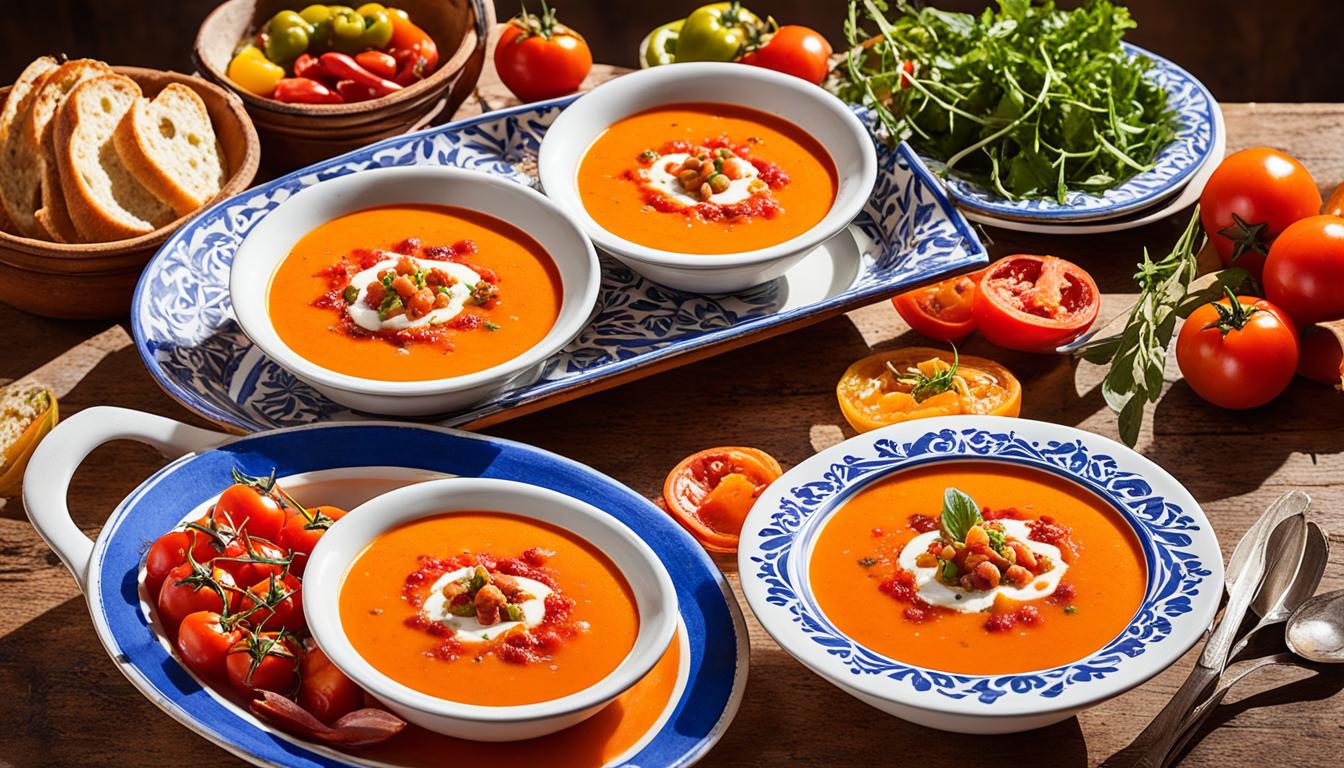Cordoba is a magical city in southern Spain, famous for its food. It’s where Moorish, Andalusian, and Spanish flavors come together. This article will guide you through Cordoba’s food scene. You’ll learn about the top dishes, traditional taverns, and cultural experiences that make the city’s food special.
Key Takeaways
- Cordoba is a hub of Andalusian gastronomy, offering a unique blend of Moorish, Spanish, and Mediterranean influences.
- The city’s food scene features a diverse range of tapas, traditional taverns, and shared dishes that are both affordable and delicious.
- Exploring the Mezquita Cathedral and the charming patios of Cordoba provides a feast for the senses, blending architectural splendor with culinary delights.
- Flamenco shows and food create a captivating fusion of Andalusian culture, while wine tours and olive oil tastings offer a gourmet’s delight.
- Cordoba’s rich Moorish heritage is reflected in its cuisine, with dishes that showcase the enduring influence of this cultural legacy.
Embark on a Delectable Journey through Cordoba’s Culinary Landscape
Cordoba’s food scene is full of flavors that show off its Moorish roots and Andalusian food traditions. Step into this world and enjoy the bold smells and tastes that make it a top food destination.
Taste the Essence of Andalusian Gastronomy
Dive into the tastes that have shaped Andalusian food for ages. Try the creamy salmorejo, a cold tomato and garlic soup that’s perfect for hot days. Enjoy the tender rabo de toro, a rich oxtail stew full of the area’s bold spices. And don’t skip the famous patatas bravas, spicy fried potatoes loved by all in Cordoba.
Discover Legendary Tapas and Traditional Taverns
Cordoba’s food scene is all about its lively tapas culture. You can move from one bustling tavern to another, trying different small plates that highlight Spanish cuisine’s variety. Taste the rich jamón ibérico (cured Iberian ham), the zesty pimientos de Padrón (Padrón peppers), and the light yet flavorful boquerones en vinagre (marinated anchovies). Each bite shows off the skill and passion of Cordoba’s chefs and the lasting traditions of its taverns.
| Andalusian Gastronomy | Tapas and Taverns |
|---|---|
|
|
“Cordoba’s culinary scene is a captivating blend of Moorish heritage and Andalusian traditions, offering a symphony of flavors that will delight your senses.”
The Mezquita Cathedral: A Feast for the Senses
No visit to Cordoba is complete without seeing the Mezquita Cathedral. This place is a mix of Islamic and Christian styles. It’s a treat for your eyes and a way to explore Cordoba’s food.
Explore Cordoba’s Iconic Landmark and Its Culinary Treasures
Inside the Mezquita, you’ll find places serving traditional Andalusian food. It’s a chance to taste the region’s flavors in a historic setting. Córdoba has two Michelin-star restaurants and four more with Bib Gourmand status. This shows its top-notch cooking skills.
From the famous Noor with its over €100 tasting menu to the simple Regadera, Cordoba’s food scene is amazing. Places like Casa Pedro Ximénez and Terra Olea bring out the city’s Moorish roots with their dishes.
“The Mezquita-Cathedral of Córdoba is a remarkable testament to the city’s cultural and architectural legacy, seamlessly blending Islamic and Christian influences.”
Walking through the Mezquita, you feel like you’re in a place where old and new meet. It invites you to enjoy not just the beauty but also the food that makes Cordoba special.
Cordoba’s Enchanting Patios and Their Gastronomic Delights
In the heart of Andalusia, Cordoba is famous for its beautiful patios, or “patios cordobeses.” These courtyards are filled with greenery, fountains, and flowers. They’re perfect for exploring the city’s tasty foods. Cordoba’s patios have restaurants and cafes that serve local dishes. This lets visitors enjoy the city’s history and taste its flavors.
The Patio Festival in May is a top event for experiencing Cordoba’s cordoba patios and gastronomic delights. Locals open their courtyards for the festival, drawing in visitors. It’s a chance to see the city’s architecture and try local foods.
For food lovers, the Mercado Victoria is a key spot in Cordoba. It’s a gourmet market where you can try Iberian ham and salmorejo, a cold tomato soup. The market’s lively feel and many stalls make it a great place to dive into Cordoba’s food scene.
“Cordoba’s culinary offerings are part of a wider experience that combines history, culture, and entertainment, making it a perfect destination for food enthusiasts.”
Cordoba’s food scene is also known for its tapas culture. You can go on a tapas crawl in the city’s busy areas. Here, small plates of local food are served with drinks. This way, visitors can try many flavors and experience the local culture.
Cordoba’s food is shaped by its history and diverse culture. You’ll find dishes inspired by Moorish and Andalusian traditions. Whether you’re in the patios, markets, or trying tapas, Cordoba’s gastronomic delights will amaze you and make you want more.
Flamenco and Food: A Captivating Fusion of Andalusian Culture
Cordoba is famous not just for its stunning architecture and delicious food. It’s also known for its flamenco, a performance that mixes music, dance, and Andalusian culture. Visitors can dive into this Spanish tradition, enjoying flamenco’s rhythms and the taste of local tapas.
Experience the Passion and Flavor of Flamenco Shows
Flamenco in Cordoba goes back to the 15th century, starting in the lively taverns of the Judería, or Jewish quarter. Now, the city’s tablaos, or traditional flamenco spots, still thrill audiences with their performances. This art form is recognized as an Intangible Cultural World Heritage.
While tasting Cordoba’s Andalusian culture, don’t miss the flamenco shows. You’ll see the dancers’ skillful footwork and hear their deep singing. The mix of flamenco and Cordoba Spain food makes for a unique cultural experience that highlights the city’s spirit.
“The clash of civilizations in Andalusia led to Christians, Muslims, and Jews experiencing persecution and adopting different strategies to protect themselves.”
- Cordoba is known for its specific palos (song forms) such as fandangos, soléa, and alegría.
- Fosforito, a revered singer from Cordoba, founded the Flamenco Centre Fosforito in the city.
- Cordoba features tablaos, traditional flamenco performance venues, still setting the standard after 200 years.
Cordoba Spain Food: The Tapas Trail
Start a fun food journey through Cordoba, Spain, where amazing tapas bring Andalusian food to life. You’ll find everything from cozy taverns to lively market stalls. Cordoba’s tapas trail is full of small plates that highlight the city’s food heritage.
Embark on a Tapas Crawl Through Cordoba’s Vibrant Neighborhoods
Cordoba is famous for its tapas bars. A tapas tour is a great way to see the city’s food scene. These tours go to 2 to 4 bars, lasting 2 to 4 hours, with groups of up to 10 people. Some tours even stop at traditional food markets for tastings, giving you a full taste of local food.
You can choose from many tapas tours in Cordoba. Pick from tapas and craft beer, tapas and flamenco, or tapas with Spanish wine. There are also private tours for a closer look at the city’s food scene.
| Cordoba Tapas Bar Highlights | Specialties to Try |
|---|---|
| Casa Pepe de la Judería | Traditional oxtail “rabo de toro” tapa |
| Bar Santos | Spanish omelette “tortilla” served outdoors near the Cathedral |
| Taberna La Montillana | Fusion of tradition and modernity, with friendly staff and quality wines |
| Taberna Salinas | Traditional “flamenquín cordobés” tapa and Andalusian-style decor |
| La Cazuela de La Espartería | Adaptation of the menu to traditional Cordoban gastronomy, including the typical “salmorejo cordobés” |
Jump into Cordoba’s lively tapas culture and find the hidden spots that make the city’s food scene special. From traditional dishes to new takes, a tapas crawl through Cordoba’s areas is a food adventure you won’t forget.
“Cordoba’s tapas trail offers a diverse array of small plates that showcase the city’s rich gastronomic heritage.”
Wine Tours and Olive Oil Tastings: A Gourmet’s Delight
Cordoba’s food scene is more than just tapas and traditional dishes. It offers a world of wine and olive oil experiences. Start a wine tour in the Montilla-Moriles region to taste montilla-moriles wines. These wines are known for their complex flavors and aromas.
Pair your wine tasting with a visit to Cordoba’s organic olive oil producers. Learn about the history and unique traits of Andalusian olive oil. It’s a chance to explore the rich heritage of olive oil in the area.
Savor the Flavors of Montilla-Moriles Wines and Organic Olive Oils
The Montilla-Moriles region is close to Cordoba and famous for its wine tours. Here, you can learn about the local sherry-style wines. These wines have unique characteristics and complex notes.
Knowledgeable sommeliers will guide you through the world of montilla-moriles wines. You’ll learn about the winemaking traditions and what makes these wines special.
After tasting wines, visit Cordoba’s olive oil tastings. Discover the world of organic olive oils. See how olive oil is made, from picking olives to getting the pure oil.
Enjoy the subtle tastes and unique smells of Andalusian olive oils. They are truly a culinary treasure.

“Indulge in the rich flavors and aromas of Cordoba’s wine and olive oil, and let your senses be transported to the heart of Andalusia.”
The Moorish Influence: A Culinary Legacy
Cordoba’s food scene is deeply influenced by its Moorish past. The Moors ruled Spain for 800 years, bringing exotic spices and new cooking ways. These changes shaped Spanish food forever.
Discover Cordoba’s Rich Moorish Heritage Through Its Cuisine
Try el puchero, a flavorful stew, to taste the Moors’ impact. Cordoba was a big city in Europe during the 10th century under Moorish rule. The Moors brought new foods like citrus fruits, rice, and sugarcane.
They also introduced deep-frying fish in olive oil. This has become a key part of Spanish cooking. Many Spanish words related to food come from Arabic, showing the deep cultural exchange.
“The Moorish legacy in the Spanish language is evident in words like ‘alcachofa’ (artichoke) and ‘almohada’ (pillow).”
Exploring Cordoba’s food scene lets you dive into its Moorish past. You’ll see how different cultures have shaped Spanish food over time.
| Moorish Influence | Impact on Spanish Cuisine |
|---|---|
| Introduction of rice and saffron | Integral to iconic dishes like paella |
| Deep-frying fish in olive oil | Transformed seafood preparation |
| Cultivation of citrus fruits, sugarcane | Expanded the range of ingredients |
| Thousands of Arabic-derived words | Linguistic interchange in food terminology |
Cooking Classes: Unlock the Secrets of Spanish Cuisine
In Cordoba, food lovers can dive into the world of Spanish cuisine with hands-on cooking classes. Local chefs and home cooks share their skills and stories. They teach you how to make classic Andalusian dishes and explain the flavors of Cordoba.
These classes let you understand Spanish cuisine better and take a bit of Cordoba back home. You’ll learn how to make tapas and use the spices and ingredients of Andalusian cooking. It’s a great way to experience the local food culture.
Explore Cordoba’s rich culture and learn about its famous Spanish cuisine through these fun classes. They’re perfect for both experienced cooks and those who love food. You’ll improve your cooking skills and remember your time in Cordoba.

“The cooking class was the highlight of my trip to Cordoba. The chef’s passion for the local ingredients and traditional recipes was truly inspiring. I left with a newfound appreciation for Spanish cuisine and the confidence to recreate these flavors in my own kitchen.”
These cooking classes in Cordoba are for everyone interested in food. They let you taste the flavors of Andalusia and learn the secrets of Spanish cooking. It’s a great way to remember your trip to this magical city.
Conclusion: A Culinary Adventure to Remember
Cordoba, Spain, is a true food lover’s dream. It invites you on a delicious journey through its rich food scene. You’ll find everything from vibrant tapas to Moorish flavors and enchanting patios.
This city is perfect for both foodies and curious travelers. Cordoba’s culinary wonders will leave a lasting mark on your taste buds and memories. It’s a top spot for anyone who loves cordoba spain food.
Michelin-starred restaurants like Choco highlight the city’s culinary talent. Chefs there mix local ingredients with old techniques to create amazing dishes.
Walking through Cordoba’s streets, you’ll find hidden food spots. This culinary adventure celebrates the city’s culture and food passion. You’ll enjoy everything from Gazpacho to Paella and Tapas. Cordoba’s food will delight and inspire you, making a lasting impression.

